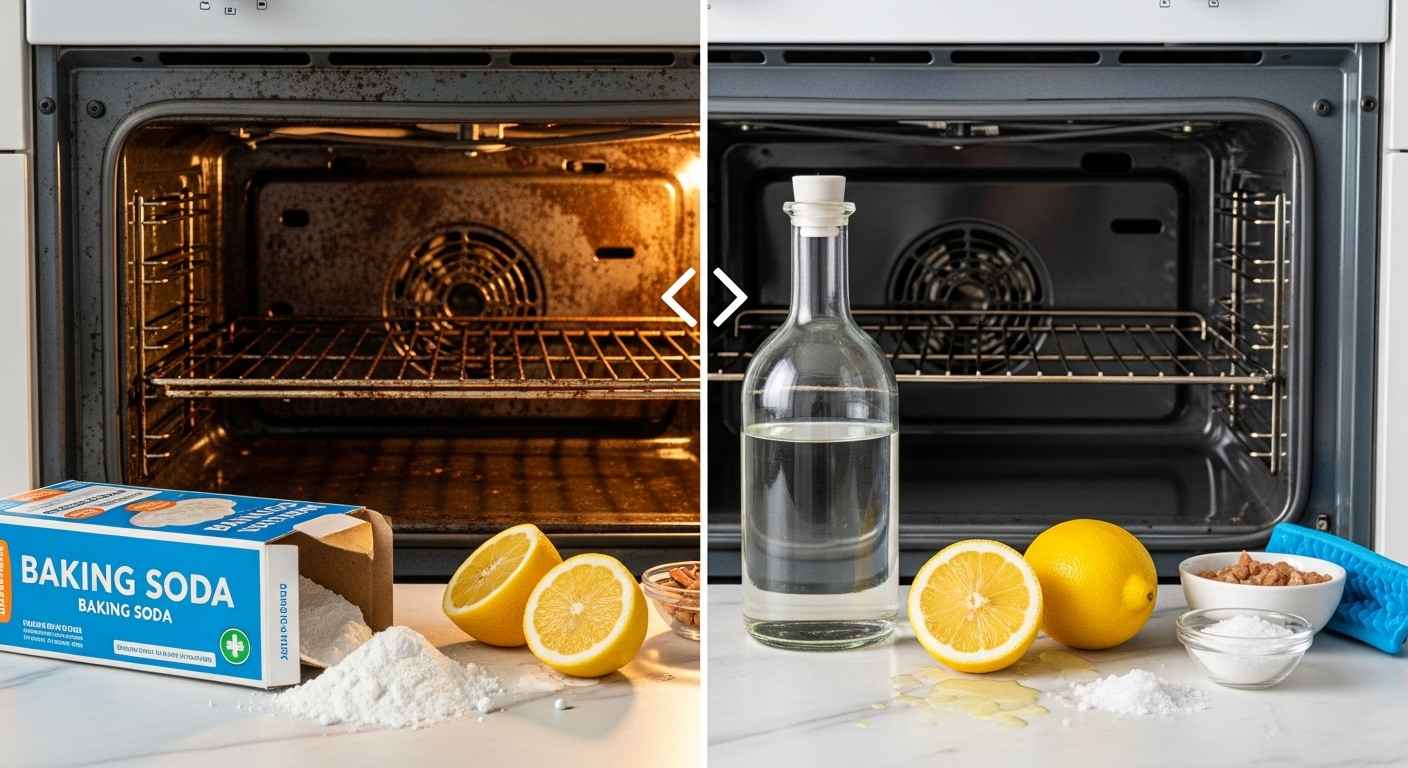Your oven doesn’t need harsh chemicals to get spotless. These proven natural cleaning methods remove baked-on grease and stubborn stains using simple ingredients you already have at home.
Why Choose Natural Oven Cleaners Over Chemical Products
Commercial oven cleaners contain toxic fumes that can harm your lungs and skin. Natural cleaning methods avoid these dangerous chemicals while delivering excellent results. Plus, you won’t worry about chemical residue affecting your food’s taste.
Natural ingredients cost less than store-bought cleaners. Most recipes use baking soda, vinegar, and lemon—items that typically cost under $10 total.
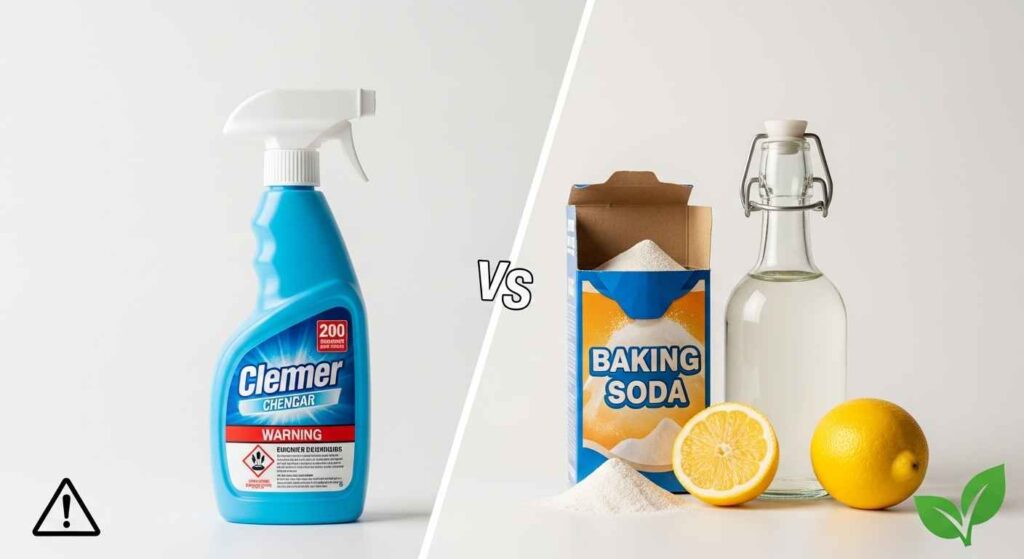
Method 1: Classic Baking Soda and Vinegar Paste
This tried-and-true combination works on most oven messes. Baking soda breaks down grease while vinegar cuts through grime and creates a gentle foaming action.
What You Need:
1/2 cup baking soda 3-4 tablespoons water White vinegar in spray bottle Damp cloth or sponge
Step-by-Step Instructions:
Remove oven racks and soak them in hot soapy water Mix baking soda with water until you get a spreadable paste Spread the paste on oven surfaces using a rubber spatula or gloved hands Let the paste sit for 12-24 hours (overnight works best) Spray vinegar over the dried paste – it will foam gently Wipe away the paste with a damp cloth For stubborn spots, scrub gently with a non-abrasive sponge
Also Reead: 7 Genius DIY Hacks to Banish Stubborn Stains Fast
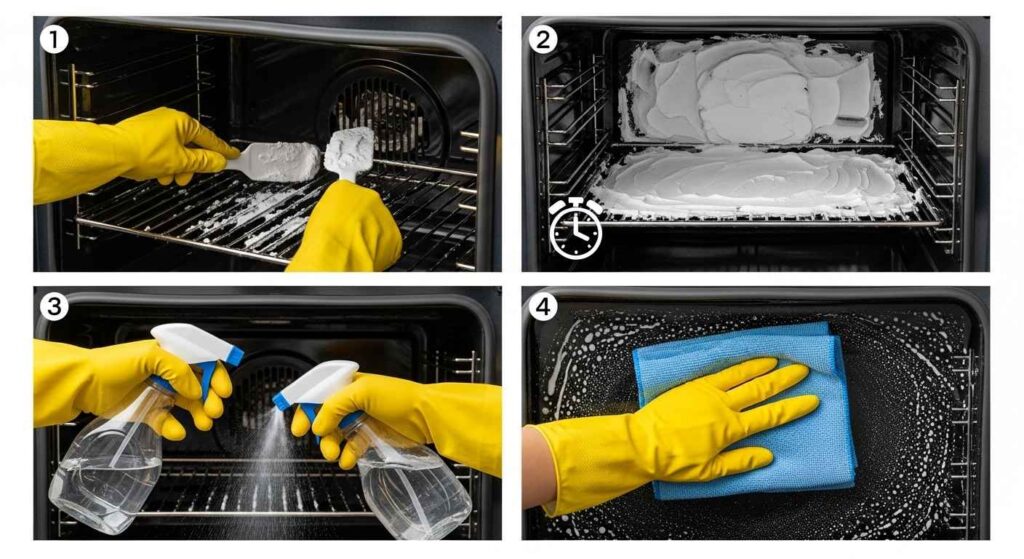
Method 2: Lemon Steam Cleaning (Fastest Method)
This method uses steam from lemon water to loosen dirt and grease naturally. Perfect for light cleaning or monthly maintenance.
What You Need:
2 large lemons Oven-safe bowl Water
Instructions:
Cut lemons in half and squeeze juice into an oven-safe bowl Add the lemon halves to the bowl Fill bowl halfway with water Place bowl on middle oven rack and heat to 250°F for 30 minutes Turn off oven and let it cool for 15 minutes Wipe down surfaces with the lemon water from the bowl Use lemon halves as natural scrubbers for tough spots
This method takes only 45 minutes total and leaves your oven smelling fresh.
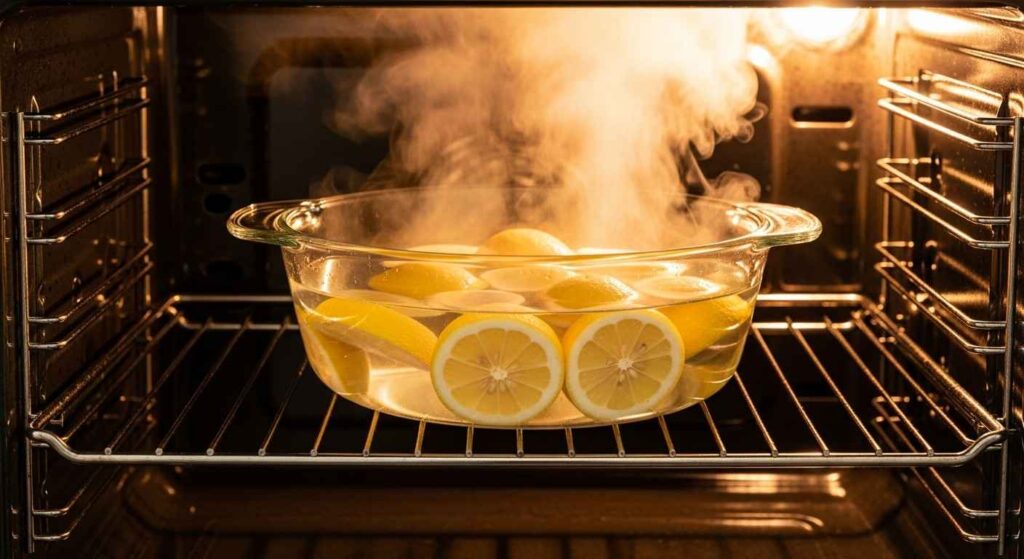
Method 3: Salt and Lemon Scrub for Heavy-Duty Cleaning
For greasy spots and baked-on food, lemon juice combined with coarse salt creates an effective abrasive paste.
Ingredients:
Juice from 2 lemons 1/4 cup coarse salt Small amount of water (if needed)
How to Use:
Mix lemon juice and salt into a thick paste, adding water if too dry Apply paste to problem areas Let sit for 20 minutes Scrub with the mixture using circular motions Rinse with warm water and dry
The salt acts as a natural abrasive while lemon cuts through grease.
Method 4: Essential Oil Power Cleaner
Essential oils like lemon, pine, and tea tree add extra cleaning power and leave a pleasant scent.
Recipe:
1/2 cup baking soda 1 tablespoon coarse salt 1/4 cup liquid dish soap 5 drops lemon essential oil 5 drops pine essential oil (optional)
Application:
Mix all ingredients into a paste Apply generous layer to oven interior and let sit several hours Scrub and wipe clean with warm water
Also Read: Best Microfiber Cloths 2025: Ultimate Cleaning Guide
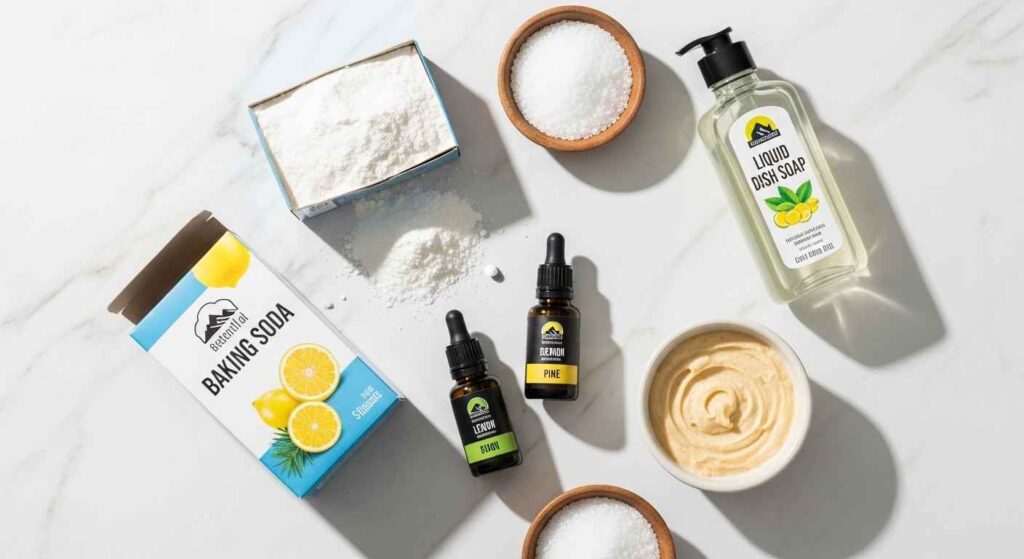
Method 5: Cornstarch and Vinegar Solution
This lesser-known method combines cornstarch with vinegar to create an effective paste cleaner.
Materials:
1 tablespoon cornstarch 1 cup white vinegar Small pot or microwave-safe bowl
Process:
Mix cornstarch and vinegar to form a paste Heat mixture until warm (microwave 30 seconds or stovetop) Let cool completely Spread on oven surfaces Wait 20 minutes then wipe off with paper towels Follow with damp cloth for final cleaning
Method 6: Dish Soap and Baking Soda Combo
This gentle method works well for regular maintenance cleaning.
You’ll Need:
Hot water Liquid dish soap Baking soda Sponge
Steps:
Fill sink with hot water Add soap and baking soda gradually until you get a thin paste consistency Let mixture sit for 2 minutes Apply with sponge using scrubbing motions Rinse thoroughly with clean water
Method 7: Steam Cleaning with Water Only
For light soil, steam alone can loosen dirt effectively.
Simple Process:
Fill large oven-safe pot with water Place in oven and heat to 450°F for 30 minutes Turn off oven and let cool Wipe surfaces while still warm and damp
Cleaning Oven Racks Naturally
Don’t forget your oven racks. Here’s how to clean them without chemicals:
Bathtub Method:
Remove racks from oven Fill bathtub with hot water Add 1/2 cup baking soda and 1/4 cup dish soap Soak racks for 4-6 hours Scrub with old toothbrush Rinse and dry completely
Outdoor Method:
Lay racks on old towels outside Spray with vinegar solution Sprinkle with baking soda Let foam for 30 minutes Scrub with brush and hose clean
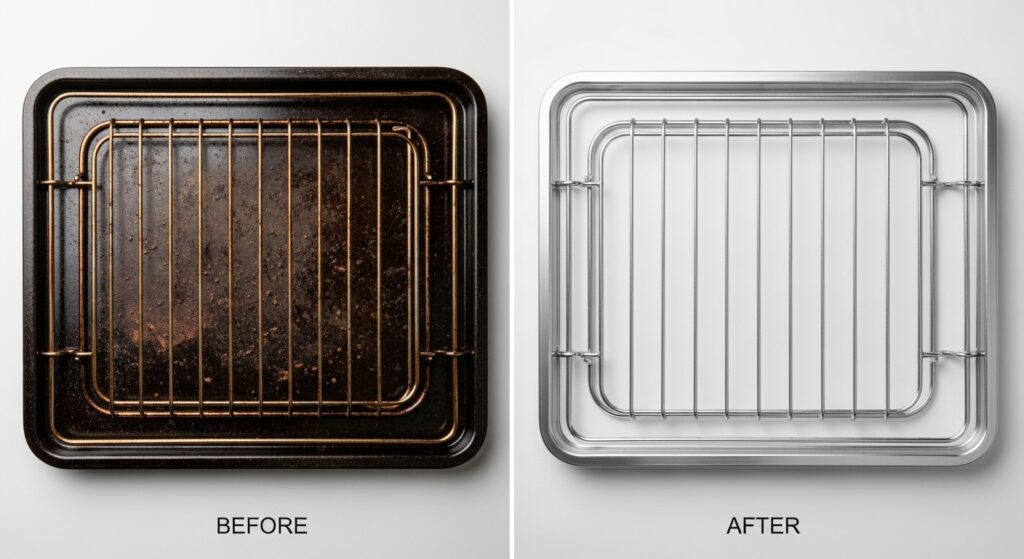
Safety Tips for Natural Oven Cleaning
Before You Start:
Always let oven cool completely Remove racks and drip pans Ventilate area by opening windows Wear rubber gloves to protect hands Avoid getting paste on heating elements
Important Warnings:
Never mix different cleaning solutions Test small area first if unsure Keep natural cleaners away from children and pets Don’t use abrasive tools on oven surfaces
Cleaning Different Oven Types
Glass Door Cleaning:
Mix lemon juice with baking soda to form a paste for cleaning oven windows. Apply, let sit 15 minutes, then wipe with soft cloth.
Self-Cleaning Ovens:
Even self-cleaning ovens benefit from natural maintenance between cycles. Use gentler methods like lemon steam or light baking soda paste.
Convection Ovens:
Clean fan blades carefully with damp cloth. Use same natural methods but avoid getting moisture in fan housing.
How Often Should You Clean Your Oven?
Light Use (1-2 times per week):
Clean every 3-4 months with natural methods
Regular Use (daily cooking):
Monthly light cleaning with lemon steam Deep clean every 6-8 weeks
Heavy Use (frequent baking):
Bi-weekly maintenance cleaning Monthly deep natural cleaning
Preventing Future Oven Messes
Simple Prevention Tips:
Use drip pans under messy dishes Clean spills immediately while warm Cover foods that tend to splatter Place foil on bottom rack (not oven floor) Wipe down after each use
Monthly Maintenance:
Quick lemon steam cleaning Wipe down door and handles Check for buildup around heating elements
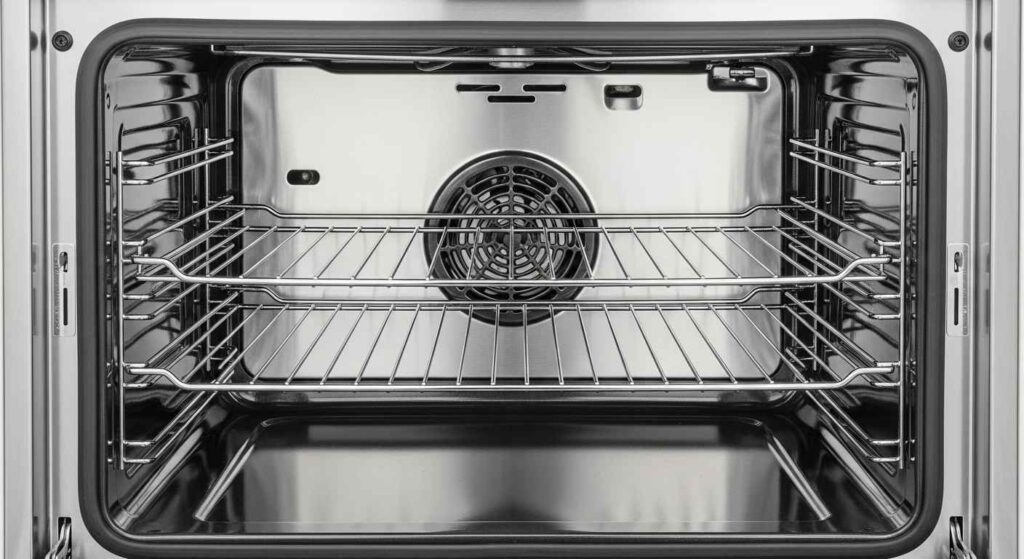
Common Mistakes to Avoid
Don’t Do These:
Using cleaning paste on heating elements Mixing vinegar and bleach (creates toxic gas) Scrubbing too hard on enamel surfaces Forgetting to remove all cleaning residue Cleaning while oven is still hot
Better Approaches:
Work around heating elements carefully Stick to one natural method at a time Use soft cloths and sponges only For stainless steel, clean with vinegar and water mixture Always do final rinse with plain water
Cost Comparison: Natural vs. Commercial Cleaners
Natural Cleaning Costs:
Baking soda (5 lb box): $3 White vinegar (1 gallon): $2 Lemons (3 pieces): $2 Total cost: $7 for multiple cleanings
Commercial Cleaner Costs:
Brand-name oven cleaner: $8-12 per bottle Usually need 2-3 applications: $16-36 Plus potential health costs from toxic exposure
Natural methods save money and protect your family’s health.
Troubleshooting Common Issues
Problem: Paste Won’t Come Off Solution: Spray with warm water, let sit 10 minutes, then scrape gently with plastic spatula
Problem: Strong Odors Remain Solution: Place bowl of baking soda in oven overnight to absorb smells
Problem: Streaks on Glass Door Solution: Final wipe with vinegar solution removes streaks
Problem: Stubborn Burnt-On Food Solution: Apply extra paste, cover with damp towel, let sit longer before scrubbing
Environmental Benefits of Natural Cleaning
Why It Matters:
Reduces toxic chemicals in your home Protects water systems from harsh detergents Uses biodegradable ingredients Eliminates plastic packaging waste from commercial cleaners Creates healthier indoor air quality
Family Health Benefits:
No respiratory irritation from fumes Safe around children and pets Reduces skin contact with harsh chemicals Won’t leave chemical residues on cooking surfaces
Also Read: Best Eco-Friendly Laundry Detergents 2025
When to Call Professionals
Sometimes professional cleaning makes sense:
Consider Professional Service If:
Oven hasn’t been cleaned in over a year Heavy grease buildup covers entire interior Natural methods aren’t removing all residue You have mobility issues that make cleaning difficult Time constraints prevent thorough cleaning
What Professionals Offer:
Specialized natural cleaning products Complete disassembly and cleaning Glass door removal and deep cleaning Heating element inspection and cleaning
Final Thoughts
Natural oven cleaning methods prove you don’t need toxic chemicals for a spotless oven. These seven proven techniques using common household ingredients deliver excellent results while protecting your family’s health and saving money.
Start with the baking soda and vinegar method for your first natural clean. Once you see the results, you’ll never go back to chemical cleaners.
Regular maintenance with natural methods keeps your oven clean year-round. Your family will appreciate the fresh, chemical-free cooking environment.
Ready to start your natural cleaning routine? Try the lemon steam method this weekend for a quick refresh, then plan a deep clean using the baking soda paste method next month.
Also Read: 15 Time-Saving Organization Systems That Actually Work for Busy Families
For more natural cleaning solutions and home organization tips, check out our other guides on creating a healthier, more organized living space.
